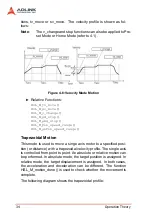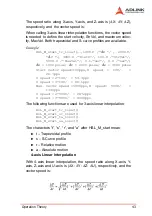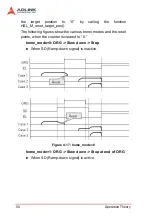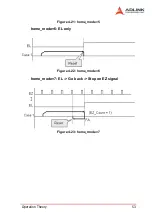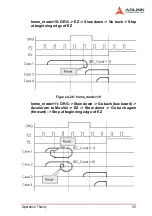
Operation Theory
43
The speed ratio along X-axis, Y-axis, and Z-axis is (
∆
X:
∆
Y:
∆
Z),
respectively, and the vector speed is:
When calling 3-axis linear interpolation functions, the vector speed
is needed to define the start velocity, StrVel, and maximum veloc-
ity, MaxVel. Both trapezoidal and S-curve profiles are available.
Example:
HSL_M_start_tr_line3(….,1000.0 /*
∆
X */ , 2000.0/
*
∆
Y */, 3000.0 /*DistZ*/, 100.0 /*StrVel*/,
5000.0 /* MaxVel*/, 0.1/*sec*/, 0.2 /*sec*/)
∆
X = 1000 pulse;
∆
Y = 2000 pulse;
∆
Z = 3000 pulse
Start
vector
speed=100pps,X speed = 100/ =
26.7pps
Y speed = 2*100/ = 53.3pps
Z speed = 3*100/ = 80.1pps
Max. vector speed =5000pps,X speed= 5000/ =
1336pps
Y speed = 2*5000/ = 2672pps
Z speed = 3*5000/ = 4008pps
The following functions are used for 3-axis linear interpolation:
HSL_M_start_tr_line3()
HSL_M_start_sr_line3()
HSL_M_start_ta_line3()
HSL_M_start_sa_line3()
The characters “t”, “s”, “r”, and “a” after HSL_M_start mean:
X
t – Trapezoidal profile
X
s – S-Curve profile
X
r – Relative motion
X
a – Absolute motion
4-axis Linear Interpolation
With 4-axis linear interpolation, the speed ratio along X-axis, Y-
axis, Z-axis and U-axis is (
∆
X:
∆
Y:
∆
Z:
∆
U), respectively, and the
vector speed is:
Summary of Contents for HSL-4XMO
Page 4: ......
Page 16: ...6 Introduction ...
Page 36: ...26 Signal Connections ...
Page 67: ...Operation Theory 57 Home Search Example Home mode 1 Figure 4 29 Home Search Example ...
Page 108: ...98 Motion Creator in LinkMaster ...






